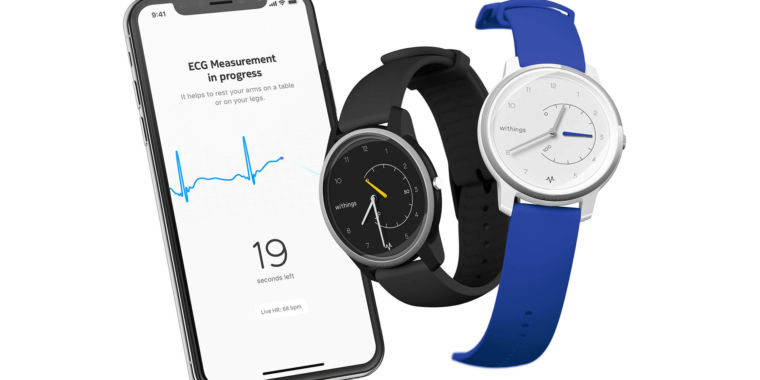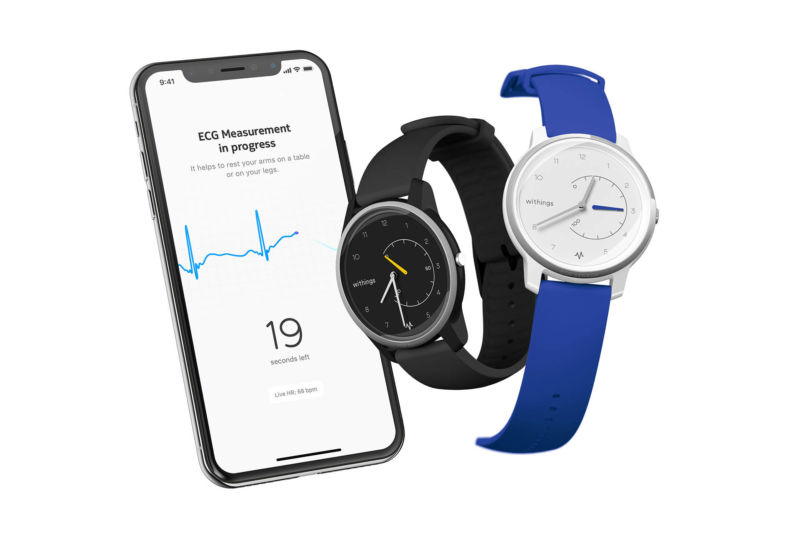

Withings has had a tumultuous couple of years. The company was bought by Nokia only to be re-acquired by its original owner Éric Carreel last May. While it sells smart scales, thermometers, and other health electronics, the French company has an uphill battle ahead of it in the wearable space thanks to an oversaturated market. But it’s aiming high with its newest device: the $129 Withings Move ECG targets those who want a more affordable device to measure electrocardiograms at home than the $350 Apple Watch.
Like Withings wearables of yesteryear, the Move ECG has an analog face but includes most of the smart technology inside that you’d expect from a modern wearable. The kickers are its three electrodes that measure electrocardiograms, two of which are embedded into the body of the watch while the third sits in the watch’s bezel. To take a reading, users need to touch both sides of the bezel at the same time while wearing the watch and wait about 30 seconds for it to take a measurement.
The process sounds nearly identical to that of the Apple Watch Series 4, which has one circular electrode on its underside and one smaller electrode on its Digital Crown. The Move ECG sends that data to Withings’ Health Mate mobile app so you can see if your heart beat was normal or if any signs of atrial fibrillation were detected. Data accumulated over time can be seen in larger charts and graphs in the app, and that data can be exported so users can easily share it with their doctors. As of today’s announcement, the Move ECG is currently under review for FDA clearance (the Apple Watch Series 4’s ECG app and its irregular rhythm notification have FDA clearance in the US).
I’m not surprised to see an ECG-focused Apple Watch competitor—in fact, I anticipate seeing more of them come out over the next year or so. The Apple Watch wasn’t the first consumer electronic to measure ECG data: devices like AliveCor’s KardiaMobile have been available for a while, although they don’t make it as easy and convenient to take a reading as the Apple Watch does (AliveCor now offers an Apple Watch band accessory in an attempt to be as convenient as the newest Apple Watch itself).
While ECG monitoring isn’t necessary for all, the Series 4 Watch made it a standard feature, and it’s been received positively since the Watch’s debut. It only takes one abnormal reading to alert you to a problem you may have been unaware of before, and for those who have heart problems, an ECG smartwatch makes monitoring your general health at home easy. I’m interested to see how the Move ECG’s readings compare to those of the Apple Watch, particularly with the extra electrode included in the former device.
In addition to ECG monitoring, the Move ECG tracks daily activity and sleep, with step-count progress shown in the sub-dial on the analog watch face. It automatically detects and tracks certain activities. Those activities include swimming, thanks to the device’s 50-meter water resistance. The Move ECG also has a connect GPS mode that lets you map outdoor activities when using the Health Mate app in conjunction with the smartwatch. However, it doesn’t have an optical heart-rate monitor, and the electrodes don’t measure heart rate outside from taking ECG measurements.
Not including a heart-rate monitor is a confusing choice, but Withings likely did so to keep the slim profile of the Move ECG (it looks more like a traditional watch than most smartwatches). Lack of a heart-rate monitor also aids battery life—the Move ECG has an estimated one-year battery life.
The Withings Move ECG costs $129 and will be available in Q2 2019.









